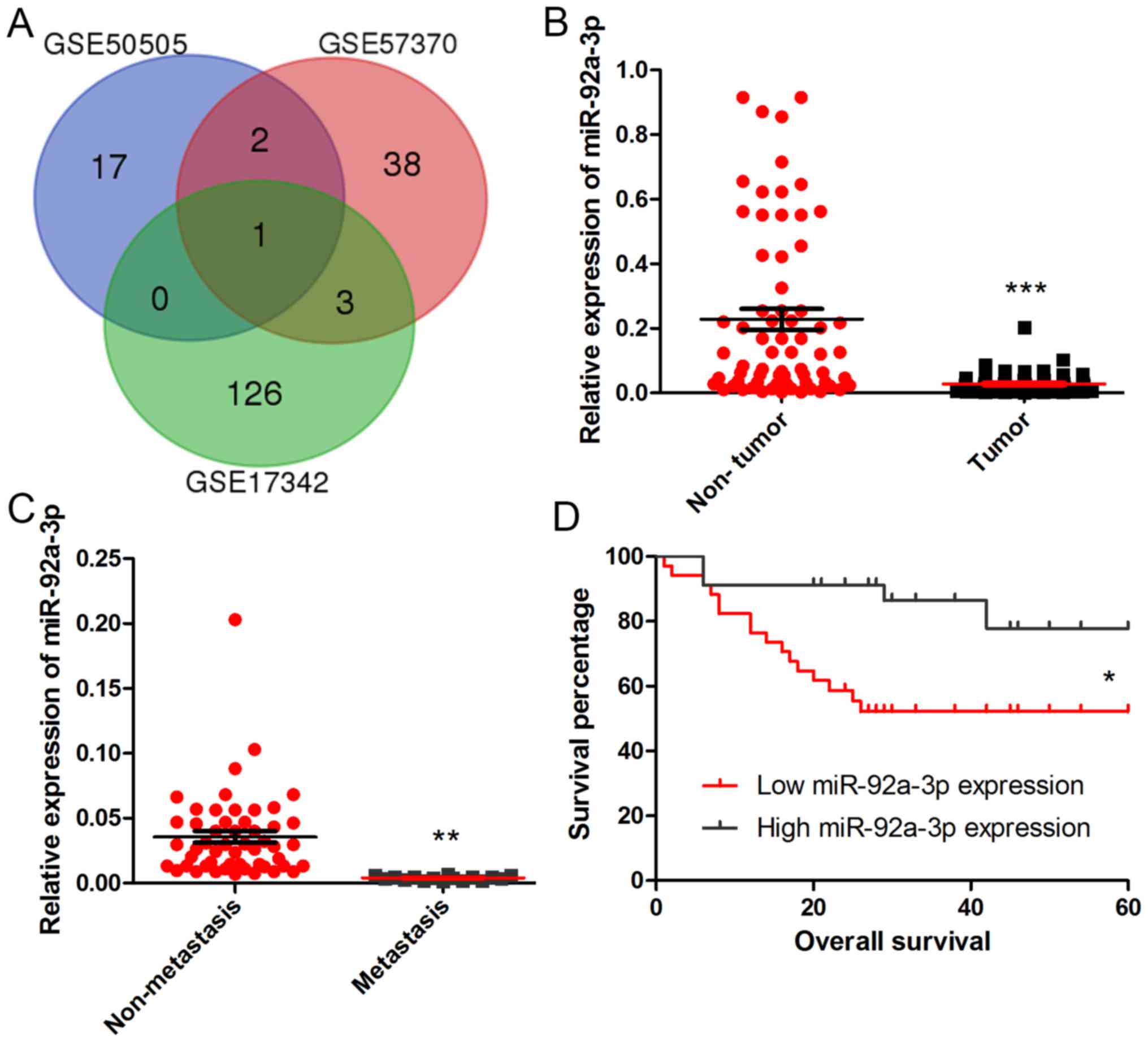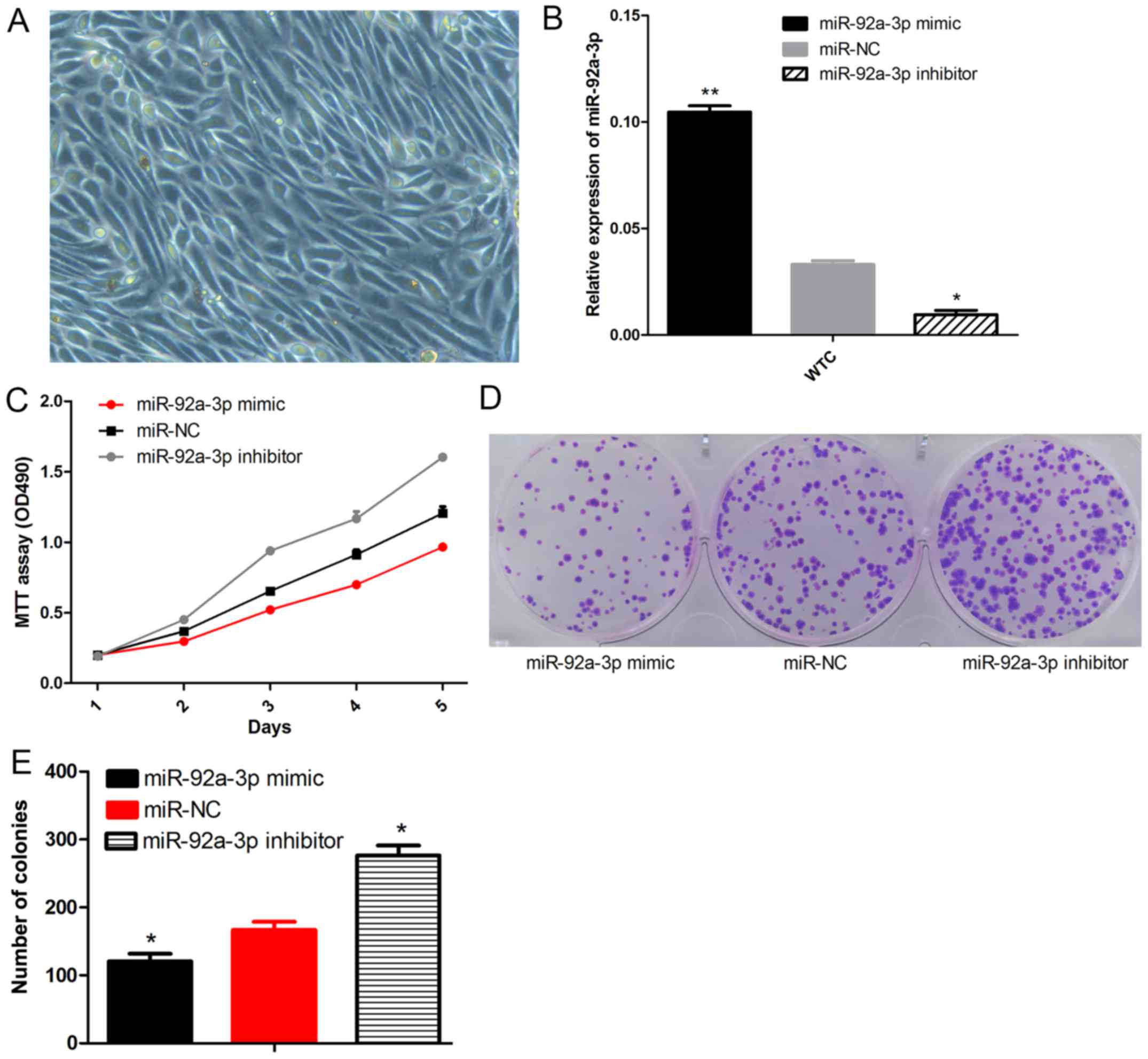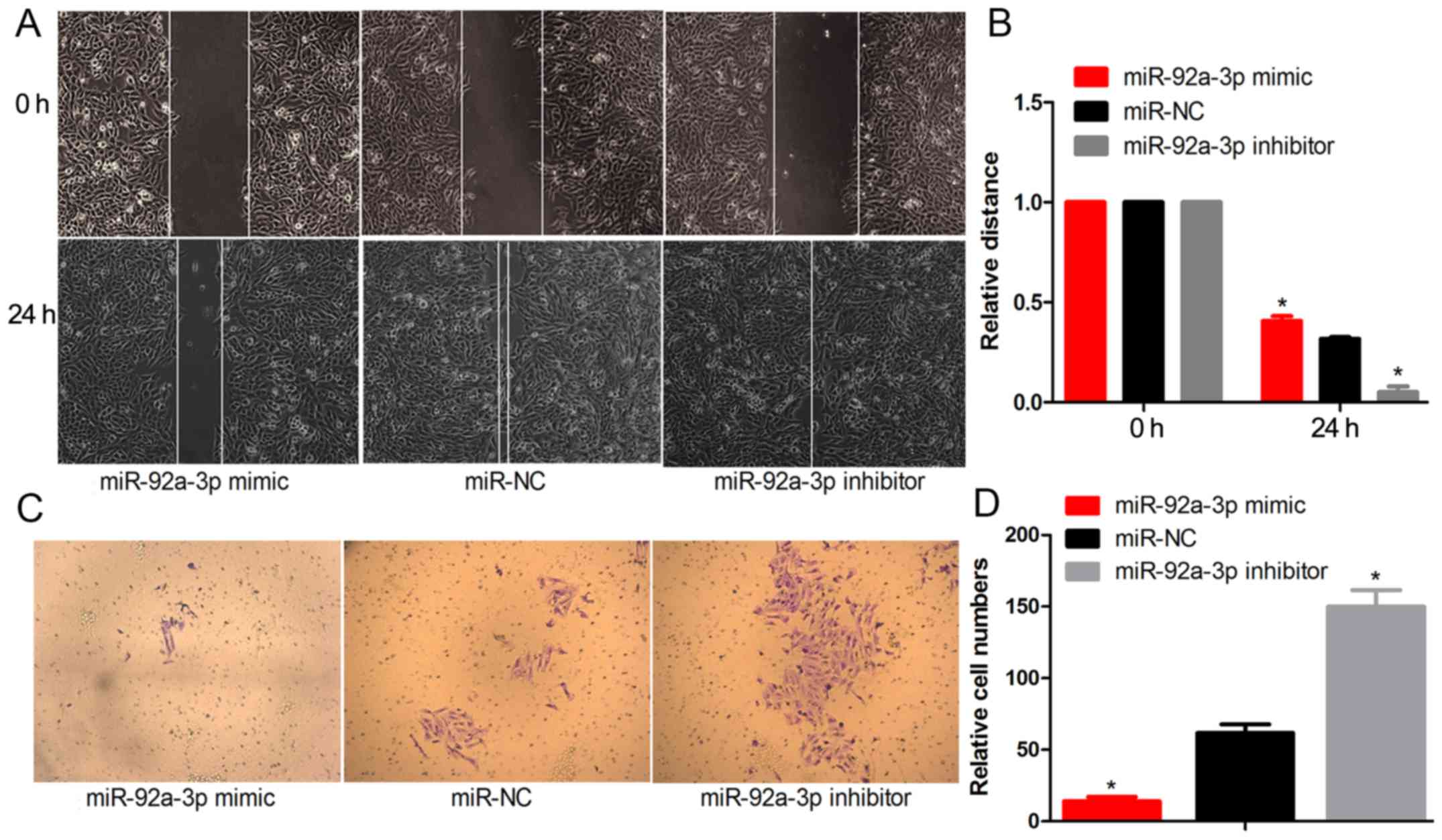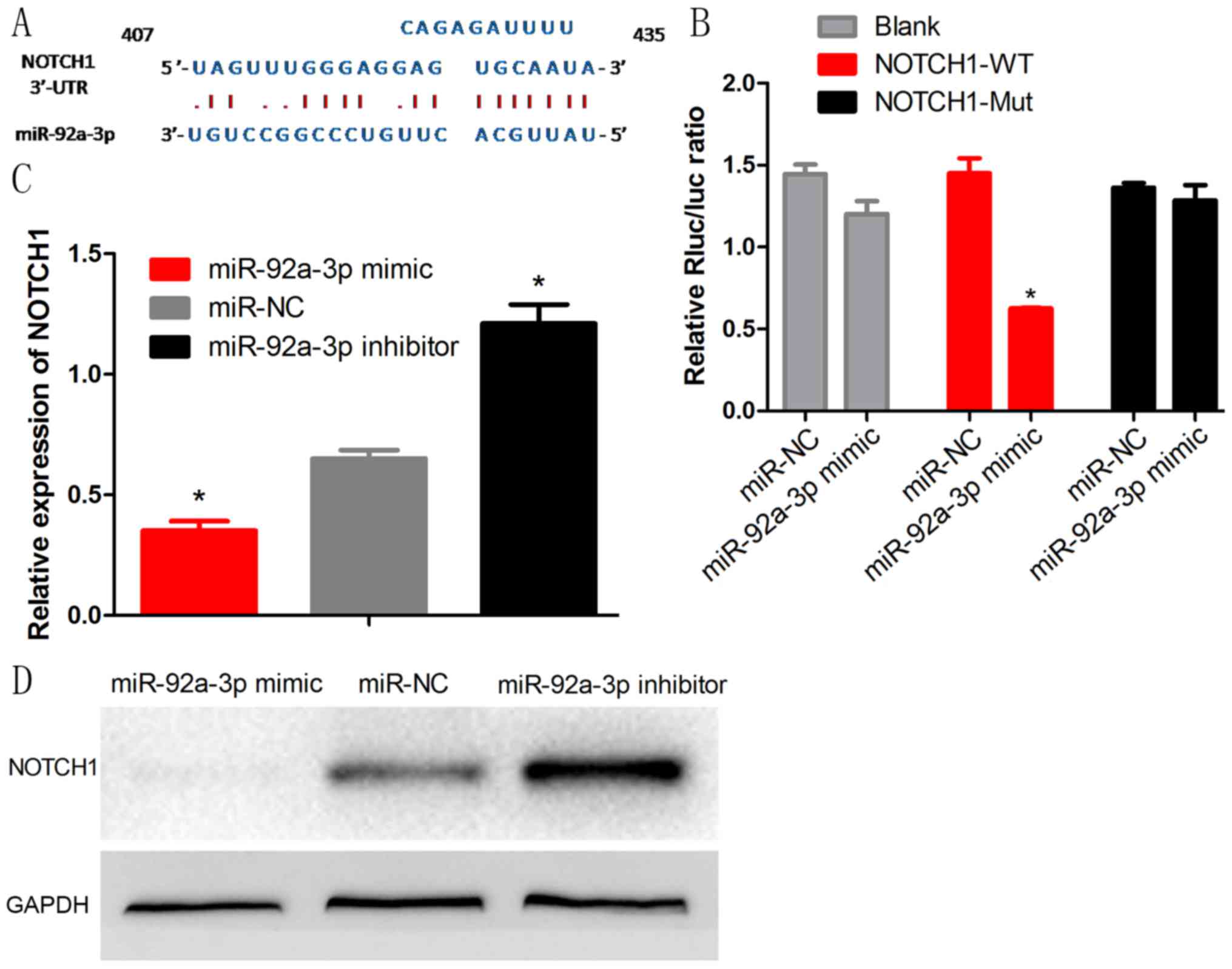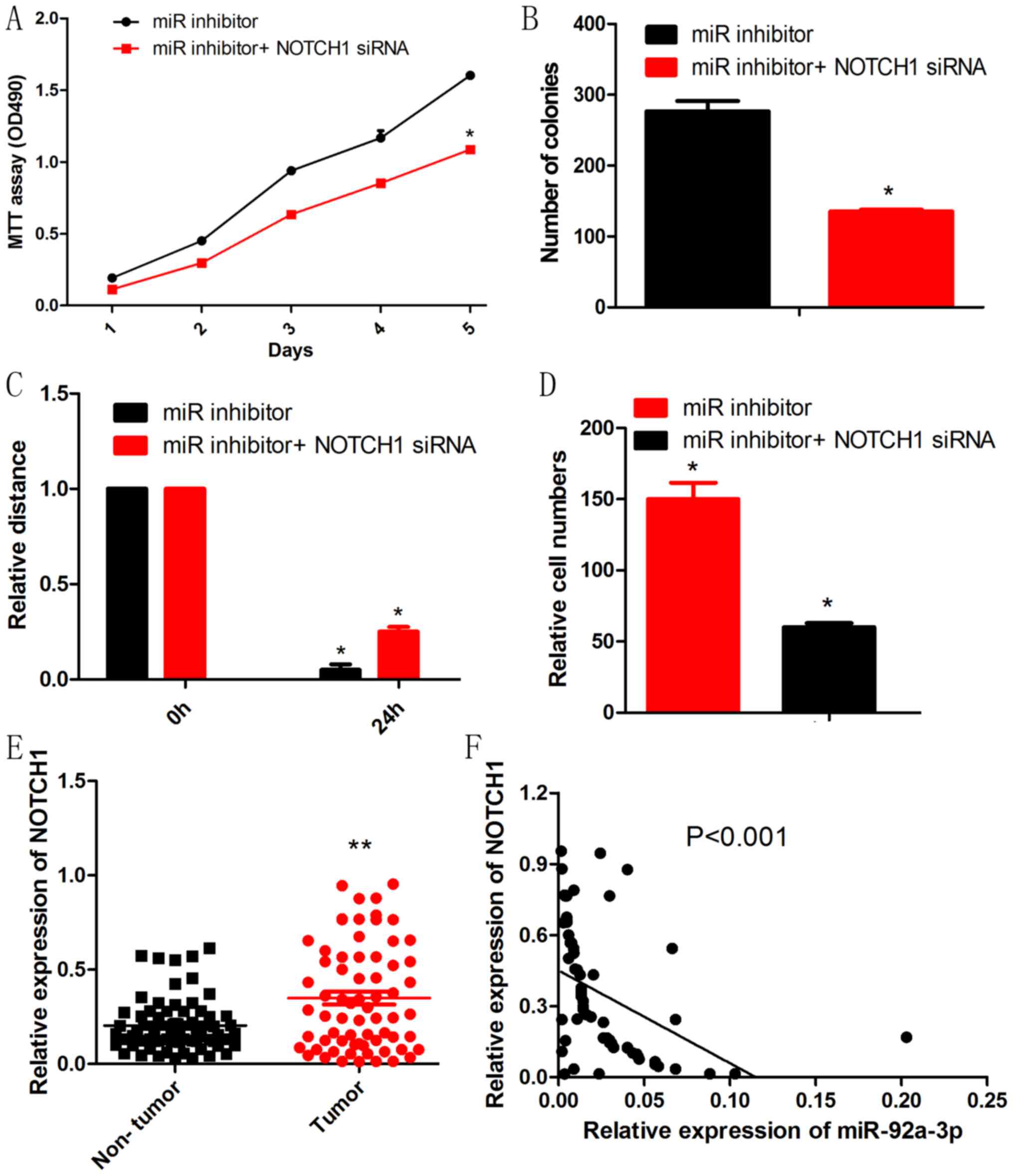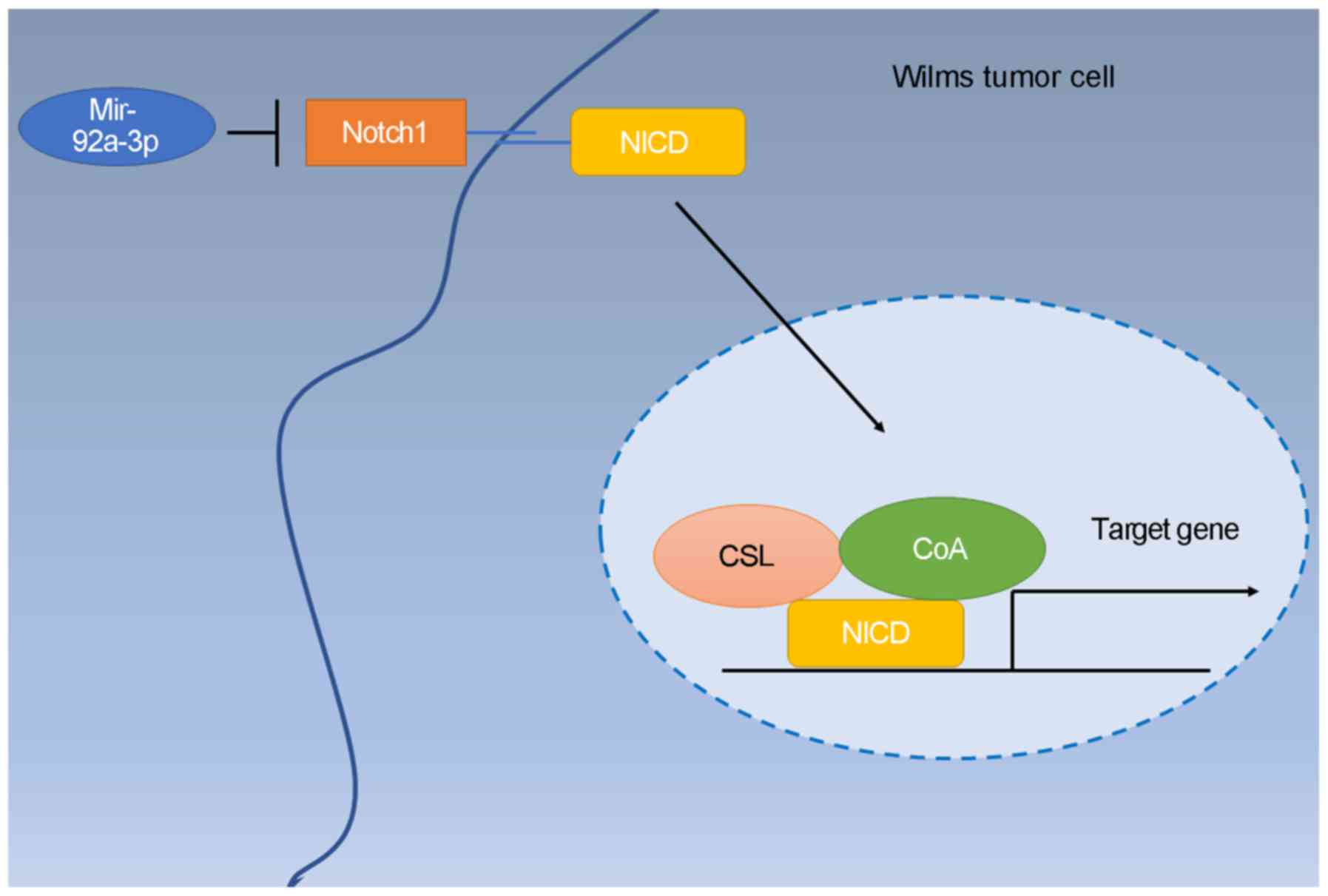MicroRNA‑92a‑3p inhibits the cell proliferation, migration and invasion of Wilms tumor by targeting NOTCH1
- Authors:
- Published online on: May 23, 2018 https://doi.org/10.3892/or.2018.6458
- Pages: 571-578
-
Copyright: © Zhu et al. This is an open access article distributed under the terms of Creative Commons Attribution License.
Abstract
Introduction
Wilms tumor is the most common pediatric renal tumor with a prevalence of ~1 in 10,000 children (1). Although combination therapy has improved the prognosis for most patients, ~10% of patients with Wilms tumors experience poor survival due to metastasis and recurrence (2–5). Hence, it is essential to elucidate the molecular mechanism underlying the tumorigenesis and metastasis of Wilms tumors, which could provide predictive and therapeutic targets for this childhood disease.
MicroRNAs (miRNAs) are a class of single-stranded, highly conserved small non-coding RNAs that regulate gene expression at the post-transcriptional level by binding to the 3′-unstranslated region (UTR) of target mRNAs, resulting in mRNA silencing or degradation (6–8). In tumors, various studies have confirmed that miRNAs function as oncogenes or tumor suppressors which regulate tumor initiation, progression and prognosis (9–11). The expression of miRNAs has been shown to be stable and an excellent marker for the early diagnosis of tumors (12).
miR-92a-3p is a member of the miR-17-92 family, which plays a critical role in modulating cell viability, apoptosis and metastasis of tumor cells (13,14). In glioma, miR-92a-3p was found to exert various effects on tumor stem-like cells by targeting the Notch-1/Akt pathway (15). In colorectal adenocarcinoma, the expression level of miR-92a-3p was able to predict the prognosis of patients (16). However, the expression level, clinicopathological and biological functions of miR-92a-3p in Wilms tumor and its underlying molecular mechanisms remain unclear. In the present study, we aimed to investigate the predicted miRNAs and the related molecular mechanisms in Wilms tumor.
Materials and methods
Microarray data
The gene expression profiles of GSE50505 (https://www.ncbi.nlm.nih.gov/geo/query/acc.cgi?acc=GSE50505), GSE57370 (https://www.ncbi.nlm.nih.gov/geo/query/acc.cgi?acc=GSE57370) and GSE17342 (https://www.ncbi.nlm.nih.gov/geo/query/acc.cgi?acc=GSE17342) were downloaded from the GEO database. GSE50505, which was based on GPL17667 platform (Luminex Homo sapiens bead-based microRNA profiling platform), was submitted by Liu et al. The dataset contained 28 samples, including 20 Wilms tumor samples and 3 normal kidney samples. GSE17342 was based on GPL8367 platform (LC_MRA-1001_miRHuman_10.0_070802), including 2 Wilms tumor samples and 2 normal kidney samples. GSE57370 was based on GPL16770 platform (Agilent-031181 Unrestricted_Human_miRNA_V16.0_Microarray), including 62 Wilms tumor samples and 4 normal kidney samples.
Patients and tissue samples
Wilms tumor tissues and the corresponding adjacent non-tumor tissues were obtained from 68 patients who had Wilms tumors and had undergone surgery at the Women and Chidren's Hospital of Guangzhou Medical University (Guangzhou, China) between July 2012 and July 2017. The age and sex distribution of WT patients are shown in Table I. Adjacent non-tumor tissues were obtained 3 cm away from the tumor, and the lack of tumor cell infiltration was verified by pathological examination. All tissue samples were frozen in liquid nitrogen and stored at −80°C. All patients had not received chemotherapy or radiotherapy before the surgery. Informed consent was obtained from each patient, and the study protocol and consent procedures were approved by the Ethics Committee of Guangzhou Medical University (Guangzhou, China).
Table I.Relationship between miR-92a-3p and the clinicopathological features of the Wilms tumor cases. |
Primary cell line and culture
The fresh tumor tissues were sliced into 0.1 cm3 pieces and washed with phosphate-buffered saline (PBS; Gibco; Thermo Fisher Scientific, Inc., Waltham, MA, USA). The tissues were then incubated overnight with 2 U/ml dispase (Gibco; Thermo Fisher Scientific, Inc.) at 4°C on a stirrer at 100 rpm, followed by digestion with 160 µg/ml of collagenase A (Sigma-Aldrich; Merck KGaA, Darmstadt, Germany) at 37°C for 3 h. Thecollected and digested cells were cultured in Dulbecco's modified Eagle's medium (DMEM; Invitrogen; Thermo Fisher Scientific, Inc.) with 10% fetal bovine serum (FBS; Invitrogen; Thermo Fisher Scientific, Inc.) until the cells had grown in a confluent monolayer at 37°C in a humidified chamber supplemented with 5% CO2. A maintenance culture was carried out in a 25-ml flask with DMEM supplemented with 10% FBS and 100 units/ml of streptomycin and 100 µg/ml penicillin (both from Gibco; Thermo Fisher Scientific, Inc.). The culture medium was replaced every 2 days and the cells were propagated every 3 days. For cryopreservation, the cells were frozen in DMEM containing 10% dimethyl sulfoxide (DMSO; Sigma-Aldrich; Merck KGaA) and 90% FBS and stored in liquid nitrogen.
Transient transfection
The miR-92a-3p mimic, miR-92a-3p inhibitor and corresponding negative control (miR-NC) were purchased from Shanghai GenePharma Co., Ltd. (Shanghai, China). The siRNA against NOTCH1 (UGGCGGGAAGUGUGAAGCG) and its negative control were provided by Takara Bio Inc. (Otsu, Japan). These molecular products were transfected into cells using Lipofectamine 2000 (Invitrogen; Thermo Fisher Scientific, Inc.) for the various experiments according to the manufacturer's instructions. Briefly, the final concentration of these products was 50 nM and the cells were harvested for subsequent experiments at 24 h after transfection. Each experiment was repeated three times each in triplicates.
RNA extraction and quantitative real-time PCR
Total RNA was isolated from the Wilms tumor tissues, matched adjacent normal tissues and WT cells using TRIzol® reagent (Invitrogen; Thermo Fisher Scientific, Inc.). Briefly, all samples were treated with TRIzol followed by chloroform. The mixture was centrifuged at 14,000 rpm for 10 min at 4°C and 700 µl 75% ethanol was added to the aqueous layer. Finally, the purified RNA was diluted with 30 µl of RNase-free water. cDNA synthesis was performed with 2 µg total RNA using the PrimeScript™ RT reagent kit with gDNA Eraser (Takara Bio, Inc., Otsu, Japan) for the next qPCR with Mir-X miRNA First-Strand Synthesis kit (Takara Bio, Inc.) for microRNA according to the manufacturers' instructions. The primers sequences of NOTCH1 were F, TGCCAGACCAACATCAAC and R, CTCATAGTCCTCGGATTGC (Takara Biotechnology, Co., Ltd., Dalian, China). The sequences of miR-92a-3p were F: GGGGCAGTTATTGCACTTGTC and R:General reverse primer for microRNA is purchased from RiboBio Co. Ltd. (Guangzhou, China). The sequences of GAPDH were F: GCACCGTCAAGGCTGAGAAC and R: TGGTGAAGACGCCAGTGGA (Takara Biotechnology). A qPCR was performed using the SYBR Premix Ex Taq II kit (Takara Bio) and the Applied Biosystems 7500 Fluorescent Quantitative PCR system (Applied Biosystems; Thermo Fisher Scientific, Inc.). The mixtures were incubated at 95°C for 30 sec, followed by 40 amplification cycles of 95°C for 5 sec and 60°C for 34 sec. The comparative cycle threshold method was used to quantify the relative expression levels of mRNA and microRNA. Expression levels of the housekeeping gene GAPDH and U6 were used to normalize the expression levels of the genes-of-interest, respectively. The relative mRNA levels were calculated based on the Ct values and normalized using the relative housekeeping gene expression.
Cell proliferation assay
In vitro cell proliferation was measured using the 3-(4,5-dimethylthiazol-2-yl)-2,5-diphenyltetrazolium bromide (MTT) method following the manufacturer's instructions (Nanjing KeyGen Biotech, Nanjing, China). Briefly, the transfected cells were seeded into 96-well plates (2×103 cells/well) and cultured for 5 days. The MTT solution (formazan in DMSO) was added to each well at the indicated time-points (1, 2, 3, 4 and 5 days) and incubated at 37°C for 4 h. The optical density value (OD) of each well was measured at 450 nm using a microplate spectrophotometer (BioTek Instruments, Inc., Winooski, VT, USA).
Cell colony formation assay
The transfected cells were seeded into 6-well plates at a density of 100 cells/well. After culture for 10 days, the colonies were washed with PBS, fixed with 4% paraformaldehyde and stained with 1% crystal violet. The colonies were imaged and counted in five randomly selected fields under a light microscope (Olympus Corp., Tokyo, Japan).
Wound healing assay
Briefly, cells (1×105) were seeded in 6-well plates and incubated overnight. A wound was created with a 10-µm pipette tip and images were obtained under a light microscope (Olympus Corp.). The wound gaps were measured per time-point.
Transwell assay
The assays were carried out in Transwell chambers (8-µm pore size) (Corning, Inc., Corning, NY, USA). Matrigel™ Matrix (BD Biosciences, San Jose, CA, USA) was diluted 1:7 using serum-free basal medium and 50 µl Matrigel Matrix dilution was added to the upper chamber of the Transwell inserts. Moreover, 100 µl transfected cell (2×105/ml) suspensions were seeded in the upper chambers precoated with Matrigel Matrix dilution in 24-well plates and cultured in serum-free basal medium. A total of 500 µl medium with 10% FBS was also added to the lower chambers. After 24 h, cells in the upper chambers were removed using cotton swabs. The inserts was washed three times with PBS, and cells that invaded to the bottom surface of the insert were fixed with 4% paraformaldehyde and stained using 1% crystal violet. The invading cells were countedunder a Leica DMI4000B microscope (Leica Microsystems, Heidelberg, Germany) from randomly selected five fields and photomicrographs were captured.
Luciferase reporter assay
The wild-type (WT) or mutant-type (MUT) seed region at the 3′UTR of NOTCH1 was synthesized and cloned into the downstream region of a firefly luciferase cassette in the pGL3-promoter vector (Promega Corporation, Madison, WI, USA) according to the manufacturer's instructions. The cells were cotransfected with vectors carrying the WT 3′UTR or MUT 3′UTR NOTCH1 and miR-92a-3p mimic or miR-NC by using Lipofectamine 2000 reagent according to the manufacturer's instructions. After a 48-h transfection, the cells were harvested to detect luciferase activity by using the Dual-Luciferase assay (Promega Corporation).
Western blotting assay
Total proteins were extracted from cells or tissues with RIPA buffer (10 mM Tris-HCl, pH 7.4, 1% Triton X-100, 0.1% SDS, 1% NP-40 and 1 mM MgCl) containing protease inhibitors. The total protein concentration was determined using a BCA Protein Assay kit (Nanjiing KeyGen Biotech). A total of 30 mg of protein was separated on a 10% SDS-polyacrylamide gel and then transferred onto polyvinylidene fluoride (PDVF) membranes (Sigma-Aldrich; Merck KGaA). The membranes were blocked with 5% milk and then incubated with primary antibodies against NOTCH1 (rabbit IgG, 1:1,000; cat. no. 3608S) and GAPDH (rabbit IgG, 1:1,000; cat. no. 5174) overnight at 4°C. On the second day, the blots were washed with PBST and incubated with secondary antibodies (anti-rabbit IgG, 1:2,000; cat. no. 7074) for 2 h at room temperature. The antibodies were purchased from Cell Signaling Technology, Inc. (Danvers, MA, USA). The protein band was visualized by chemiluminescence imaging system (ChemiDoc Touch; Bio-Rad Laboratories, Hercules, CA, USA). GAPDH was used as an internal control.
Statistical analysis
For comparisons, two-tailed Student's t-test, Wilcoxon rank-test, Fisher's exact test, one-way analysis of variance (ANOVA) test and the Kruskal-Wallis test were performed. Overall survival (OS) was calculated and multivariate Cox's proportional harzards model was performed to determine the independent factors. Survival curves were performed by Kaplan-Meier's method and calculated by log-rank test. For correlation, Spearman's and Pearson's correlation were used. Statistical analyses were conducted using SPSS 13.0 software (SPSS, Inc., Chicago, IL, USA) with a two-sided significance level of P<0.05.
Results
miR-92a-3p is downregulated in Wilms tumors
To reveal the expression of miRNAs in Wilms tumor, we downloaded the microarray chips concerning the miRNA gene expression profiles of GSE50505, GSE57370 and GSE17342. We chose the genes with P<0.05 and fold control (FC) 1.5 as criteria. After analysis with InteractiVenn, we obtained a common gene miR-92a-3p (Fig. 1A). To reveal the role of miR-92a-3p in Wilms tumor, RT-qPCR was performed to examine the expression levels of miR-92a-3p in tumor samples and adjacent non-tumor tissues of 68 Wilms tumor patients. As revealed in Fig. 1B, miR-92a-3p was frequently downregulated in Wilms tumor, compared with that in the adjacent tissues (P<0.001). To further investigate the clinical significance of miR-92a-3p expression in Wilms tumor, we tested the expression level of miR-92a-3p in patients with or without metastasis and found that miR-92a-3p expression was lower in patients with metastasis than patients without metastasis (P<0.01) (Fig. 1C). We divided the 68 patients into two groups according to the median value of miR-92a-3p expression in the Wilms tumors: high miR-92a-3p expression group and low miR-92a-3p expression group (Table I). In addition, Kaplan-Meier's analysis (Fig. 1D) indicated that Wilms tumor patients with low miR-92a-3p expression exhibited poorer overall survival (P<0.05).
miR-92a-3p inhibits Wilms tumor cell proliferation and colony formation
To examine the effect of miR-92a-3p on Wilms tumor growth, we obtained the primary cells from a Wilms tumor (Fig. 2A). The Wilms tumor cells were then transfected with the miR-92a-3p mimic, miR-NC and inhibitor. miR-92a-3p expression was comfirmed by qPCR (Fig. 2B). The MTT assay (Fig. 2C) indicated that WT cells with higher miR-92a-3p expression exhibited reduced proliferation compared to the cells transfected with miR-NC. In contrast, the Wilms tumor cells with low miR-92a-3p expression exhibited increased proliferation (P<0.05). The colony formation assay (Fig. 2D and E) demonstrated that Wilms tumor cells transfected with the miR-92a-3p mimic developed significantly lower rates of colony formation when compared with the cells transfected with miR-NC. Additionaly, Wilms tumor cells transfected with the miR-92a-3p inhibitor had a higher rate of colony formation (P<0.05). These results suggest that miR-92a-3p inhibitedthe proliferation and colony formation of Wilms tumor cells.
miR-92a-3p inhibits Wilms tumor cell migration and invasion
To measure the effect of miR-92a-3p on the migratory and invasive capacities of the Wilms tumor cells, we used Matrigel-coated Transwell experiments and wound healing assays. The results revealed a significant decrease in the wound-healing distance in the miR-92a-3p mimic-transfected WT cells after 24 h. Meanwhile, the wound-healing distance of the miR-92a-3p inhibitor-transfected Wilms tumor cells was more extensive when compared with the miR-NC cells (Fig. 3A and B). We observed that the miR-92a-3p mimic significantly decreased the invasiveness of the Wilms tumor cells through Matrigel. The miR-92a-3p inhibitor increased the invasion potential of the Wilms tumor cells (Fig. 3C and D). These results demonstrated that miR-92a-3p inhibits the potential of Wilms tumor cells in terms of migration and invasion.
NOTCH1 is a direct target of miR-92a-3p in Wilms tumor
To explore the molecular mechanism by which miR-92a-3p functions in Wilms tumor, we used bioinformatic prediction software (TargetScan) to determine the potential target. We identified that miR-92a-3p was able to bind the 3′-UTR of NOTCH1 (Fig. 4A). To further confirm this binding, we performed a luciferase assay and demonstrated that miR-92a-3p dramatically inhibited the luferase activity of the wild-type (WT) 3′-UTR but not of the mutant-type (Mut) 3′-UTR and blank vector of NOTCH1 (Fig. 4B). Moreover, miR-92a-3p mimic significantly inhibited mRNA and protein expression of NOTCH1 and the inhibitor promoted the NOTCH1 expression (Fig. 4C and D).
NOTCH1 knockdown rescued the effect of miR-92a-3p inhibitor on Wilms tumor cells
To further determine whether NOTCH1 is a functional target of miR-92a-3p in Wilms tumor, we performed a rescue experiment. NOTCH1 siRNA reduced the promotive effects of the miR-92a-3p inhibitor on proliferation, migration and invasion of Wilms tumor cells (Fig. 5A-D). To explore the relationship between miR-92a-3p and NOCTH1 in Wilms tumortissues, RT-qPCR was performed to test the expression of NOTCH1. As shown in Fig. 5E, Wilms tumor tissues had significantly higher levels of NOTCH1 mRNA than those of adjacent non-tumor tissues. Moreover, NOTCH1 mRNA had an inverse correlation with miR-92a-3p expression in Wilms tumor tissues (Fig. 5F).
Discussion
A series of microarray chips have been used to detect the miRNA expression of Wilms tumors and these studies reported the abnormal expression levels of various miRNAs in Wilms tumor, such as the upregulated genes, miR-378 and miR-18b and the downregulated genes, miR-193a-5p and miR-199a-5p (5,17). However, studiesconcerning the cliniopathological and biological mechanisms concerning miRNAs in Wilms tumors are sparse. In the present study, we extracted the data from microarray profiles of GSE50505, GSE57370 and GSE17342, including thousands of miRNA genes in the human genome simultaneously, which has been widely used to predict the potential therapeutic targets for tumors. Notably, we identified a common downregulated gene miR-92a-3p in Wilms tumor. The present study further confirmed the low expression of miR-92a-3p in Wilms tumor and we also found that overexpression of miR-92a-3p inhibited the proliferation, migration and invasion of Wilms tumor cells. In addition, miR-92a-3p knockdown showed contrary results. These results indicate that miR-92a-3p may serve as a tumor suppressor.
NOTCH1 is a member of the Notch family, the evolutionarily conserved family of transmembrane receptors, which regulate cell fate, stem cell self-renewal and differentiation during development (18,19). Recently, Notch1 was reported to take part in diverse tumor processes including cell proliferation, apoptosis, and cancer metastasis and angiogenesis in various types of cancer (20,21). In addition, in kidney development, Notch receptors were reported to regulate mesangial cell specification, proliferation or survival (22). These results suggest that NOTCH family receptors may play pivotal roles in Wilms tumor. In the present study, we found that the expression of NOTCH1 was downregulated by miR-92a-3p mimic, and NOTCH1 was upregulated by the miR-92a-3p inhibitor. Moreover, the functions of miR-92a-3p inhibitor on Wilms tumor were reversed by NOTCH1 knockdown. The expression of NOTCH1 and miR-92a-3p had an obvious negative correlation in Wilms tumor. The results above suggest that NOTCH1 is a direct target of miR-92a-3p and miR-92a-3p inhibits the proliferation, migration and invasion of Wilms tumor by targeting NOTCH1.
In conclusion, the present study demonstrated that miR-92a-3p was downregulated inWilms tumor tissues and significantly correlated with the lung metastasis of patients. Furthermore, miR-92a-3p mimics suppressed Wilms tumor cell proliferation, migration and invasion. Additionally, miR-92a-3p knockdown promoted the progression. Moreover, NOTCH1 is a direct target of miR-92a-3p and miR-92a-3p inhibits tumor progression by targeting NOTCH1. Knockdown of NOTCH1 expression reversed the promotive effect of the miR-92a-3p inhibitor on Wilms tumor progression. In conclusion, miR-92a-3p blocks the progression of Wilms tumor by targeting NOTCH1 (Fig. 6).
Acknowledgements
The authors thank Mr. zhongmin Li for his technical support.
Funding
The present study was supported by a grant from the Guangdong Provincial Department of Science and Technology Foundation, P.R. China (no. 2016A020215009).
Availability of data and materials
All data generated or analyzed during this study are included in this published article.
Authors' contributions
GL and WJ designed the study; SZ wrote the manuscript, collected clinical information and performed statistical analyses; ZZ and WF assisted with PCR, western blotting and in vitro experiments; LZ assisted with the Dual-Luciferase reporter assays. All authors read and approved the manuscript and agree to be accountable for all aspects of the research in ensuring that the accuracy or integrity of any part of the work are appropriately investigated and resolved.
Ethics approval and consent to participate
Informed consent was obtained from each patient, and the study protocol and consent procedures were approved by the Ethics Committee of Guangzhou Medical University (Guangzhou, China).
Consent for publication
Not applicable.
Competing interests
The authors declare that they have no competing interests.
References
|
Charlton J, Pavasovic V and Pritchard-Jones K: Biomarkers to detect Wilms tumors in pediatric patients: Where are we now? Future Oncol. 11:2221–2234. 2015. View Article : Google Scholar : PubMed/NCBI | |
|
Cone EB, Dalton SS, Van Noord M, Tracy ET, Rice HE and Routh JC: Biomarkers for wilms tumor: A systematic review. J Urol. 196:1530–1535. 2016. View Article : Google Scholar : PubMed/NCBI | |
|
Qi C, Hu Y, Yang F, An H, Zhang J, Jin H and Guo F: Preliminary observations regarding the expression of collagen triple helix repeat-containing 1 is an independent prognostic factor for Wilms' tumor. J Pediatr Surg. 51:1501–1506. 2016. View Article : Google Scholar : PubMed/NCBI | |
|
Brok J, Pritchard-Jones K, Geller JI and Spreafico F: Review of phase I and II trials for Wilms' tumour e Can we optimise the search for novel agents? Eur J Cancer. 79:205–213. 2017. View Article : Google Scholar : PubMed/NCBI | |
|
Yu X, Li Z, Chan MT and Wu WK: The roles of microRNAs in Wilms' tumors. Tumor Biol. 37:1445–1450. 2016. View Article : Google Scholar | |
|
Macfarlane LA and Murphy PR: MicroRNA: Biogenesis, function and role in cancer. Curr Genomics. 11:537–561. 2010. View Article : Google Scholar : PubMed/NCBI | |
|
Bushati N and Cohen SM: MicroRNA functions. Annu Rev Cell Dev Biol. 23:175–205. 2007. View Article : Google Scholar : PubMed/NCBI | |
|
Valinezhad Orang A, Safaralizadeh R and Kazemzadeh-Bavili M: Mechanisms of miRNA-mediated gene regulation from common down-regulation to mRNA-specifc upregulation. Int J Genomics. 2014:9706072014. View Article : Google Scholar : PubMed/NCBI | |
|
Tie J and Fan D: Big roles of microRNAs in tumorigenesis and tumor development. Histol Histopathol. 26:1353–1361. 2011.PubMed/NCBI | |
|
Hwang HW and Mendell JT: MicroRNAs in cell proliferation, cell death, and tumorigenesis. Br J Cancer. 94:776–780. 2006. View Article : Google Scholar : PubMed/NCBI | |
|
Baltimore D, Boldin MP, O'Connell RM, Rao DS and Taganov KD: MicroRNAs: New regulators of immune cell development and function. Nat Immunol. 9:839–845. 2008. View Article : Google Scholar : PubMed/NCBI | |
|
Zhang C, Wang C, Chen X, Yang C, Li K, Wang J, Dai J, Hu Z, Zhou X, Chen L, et al: Expression profile of microRNAs in serum: A fingerprint for esophageal squamous cell carcinoma. Clin Chem. 56:1871–1879. 2010. View Article : Google Scholar : PubMed/NCBI | |
|
Ma H, Pan JS, Jin LX, Wu J, Ren YD, Chen P, Xiao C and Han J: MicroRNA-17-92 inhibits colorectal cancer progression by targeting angiogenesis. Cancer Lett. 376:293–302. 2016. View Article : Google Scholar : PubMed/NCBI | |
|
Zhou P, Ma L, Zhou J, Jiang M, Rao E, Zhao Y and Guo F: miR-17-92 plays an oncogenic role and conveys chemoresistance to cisplatin in human prostate cancer cells. Int J Oncol. 48:1737–1748. 2016. View Article : Google Scholar : PubMed/NCBI | |
|
Song H, Zhang Y, Liu N, Zhao S, Kong Y and Yuan L: miR-92a-3p exerts various effects in glioma and glioma stem-Like cells specifically targeting CDH1/v-catenin and Notch-1/Akt signaling pathways. Int J Mol Sci. 17:pii: E1799. 2016. View Article : Google Scholar | |
|
Zheng G, Du L, Yang X, Zhang X, Wang L, Yang Y, Li J and Wang C: Serum microRNA panel as biomarkers for early diagnosis of colorectal adenocarcinoma. Br J Cancer. 111:1985–1992. 2014. View Article : Google Scholar : PubMed/NCBI | |
|
Watson JA, Bryan K, Williams R, Popov S, Vujanic G, Coulomb A, Boccon-Gibod L, Graf N, Pritchard-Jones K and O'Sullivan M: MiRNA profiles as a predictor of chemoresponsiveness in Wilms' tumor blastema. PLoS One. 8:534172013. View Article : Google Scholar | |
|
Kopan R and Ilagan MX: The canonical Notch signaling pathway: Unfolding the activation mechanism. Cell. 137:216–233. 2009. View Article : Google Scholar : PubMed/NCBI | |
|
Fortini ME: Notch signaling: The core pathway and its posttranslational regulation. Dev Cell. 16:633–647. 2009. View Article : Google Scholar : PubMed/NCBI | |
|
Bolos V, Grego-Bessa J and de la Pompa JL: Notch signaling in development and cancer. Endocr Rev. 28:339–363. 2007. View Article : Google Scholar : PubMed/NCBI | |
|
Xu P, Qiu M, Zhang Z, Kang C, Jiang R, Jia Z, Wang G, Jiang H and Pu P: The oncogenic roles of Notch1 in astrocytic gliomas in vitro and in vivo. J Neurooncol. 97:41–51. 2010. View Article : Google Scholar : PubMed/NCBI | |
|
Boyle SC, Liu Z and Kopan R: Notch signaling is required for the formation of mesangial cells from a stromal mesenchyme precursor during kidney development. Development. 141:345–354. 2014. View Article : Google Scholar |



